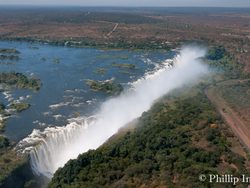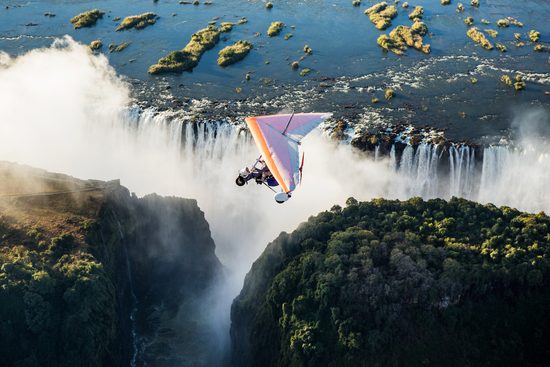
Quick Navigation
Victoria Falls National Park is the Zimbabwe protected area of the shared natural wonder of Victoria Falls with Zambia’s protected area being Mosi-oa-Tunya National Park. Together, these two national parks protect the world's largest waterfall.
Victoria Falls is a UNESCO World Heritage Site recognizing this feat of nature as the largest waterfall in the world. The falls reach a height of 355 feet (108 m) and stretch across 5,604 feet (1,708 m) creating the largest single sheet of falling water.
Victoria Falls National Park is even smaller than its neighboring Mosi-oa-Tunya covering an area of only 9 square miles (23.4 sq km). The Zambezi River is the source of the falls which also serves as part of the border between Zambia and Zimbabwe.
Victoria Falls is actually comprised of five individual falls, of which, four of them are located on the Zimbabwe side of the border. These include Devil's Cataract, Main Falls, Rainbow Falls, and Horseshoe Falls. The fifth Eastern Cataract is located on the Zambia side of the border.
Elephant, buffalo, white rhino, eland, hippo, and varying antelope can be experienced with short game drives in the park. Animals are not the reason to visit, but they do add to the overall nature experience. There is also a massive balboa tree that measures 52 feet (16 m) in diameter and 65.6 feet (20 m) high.
Highlights
Victoria Falls Highlights:

It is imperative that you leverage the microlites or a helicopter and get an aerial view of the falls. This is one of the best ways to capture the grandeur of Victoria Falls.
Devil's Cataract
The Devil's Cataract is approximately 229 feet (70 m) deep. Locals historically performed sacrificial ceremonies on an island until missionaries identified this activity as "devilish." This led to the naming of the area and subsequent part of the falls.
Main Falls
This part of the larger collection of waterfalls is often considered the most spectacular. This is one of the widest curtains of water which drop 305 feet (93 m) to the canyon floor. This powerful flow of water creates an abundance of spray which triggers many of the rainbows. The spray also leads to the abundant rainforest around the gorge.
Horseshoe Falls
This horseshoe-shaped part of the falls drops 311.7 feet (95 m) to the gorge floor. The part of Victoria Falls often dries up during the dry season which occurs during the months of late September through November. This is the deepest part of the whole falls.
Eastern Cataract
The Eastern Cataract occurs on the Zambian side, however, the Zimbabwean side offers some of the amazing views of that part of the falls.
It is imperative to crossover the border and to experience the falls from both sides of the border. It really is two different experiences. The Zimbabwe side offers the most expansive view of the falls. During the dry season, this side of the falls has the greatest chance of flowing water into the canyon below.
You will find multiple views of rainbows as you explore the face of the falls as well as moving upriver to look out over the falls. Make sure you capture both images and videos of this world wonder.

Helicopter Tour
An aerial approach provides one of the most astounding views of Victoria Falls. You can take a helicopter ride up over the falls and really witness the majestic expance of this natural wonder.

Sunset Dinner Cruise
Board your boat and be prepared for both a culinary experience and a view of one of the most striking sunsets in the world. You will be captivated.

Microlight Flights
Cross over the border and take advantage of a more exhilerating aerial view. The piloted microlights will let you have a more intimate look at the waterfall.
Victoria Falls National Park Trails
Victoria Falls on the Zimbabwean side is well paved and fairly accessible. There are some stairs, but apart from that just follow the path. There are no trails in the wilderness part of the park. This is accessed by a vehicle as you drive through the park with a chance to see wildlife as well as the protected enormous balboa tree.
You can navigate the paved-trail fairly quickly, but you should probably allow for a couple of hours to really take in the falls, which are the reason that you came. Looking up the gorge and along the face of the falls is one of the most impressive views which is delivered along this trail. More than likely, you will see more than one rainbow hovering over the canyon.
There are guided walking safaris that allow you to explore the region on foot, but these are experiences are not really on traditional trails.
Victoria Falls Highlights
- Victoria Falls, the world’s largest waterfall
- Devil’s pool atop the falls during the dry season
- The most complete view of the falls on land
- Moonbows during the nights with a full moon.
- Walking safaris
Park Map
Sources
- Britannica, Victoria Falls, https://www.britannica.com/place/Victoria-Falls-waterfall-Zambia-Zimbabwe, retrieved June 2020.
- Seven Natural Wonders, Victoria Falls, Seven Natural Wonders of the World, retrieved June 2020.
- UNESCO, Victoria Falls, https://whc.unesco.org/en/list/509/, retrieved July 2019.
- Victoria Falls Guide, https://www.victoriafalls-guide.net/victoria-falls-entrance.html, retrieved July 2019.
- Zimbabwe's Parks and Wildlife Management, Victoria Falls, https://zimparks.org/parks/national-parks/victoria-falls/, retrieved June 2020.
















